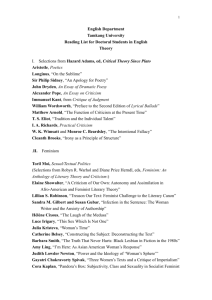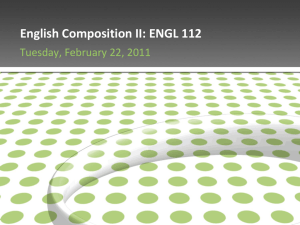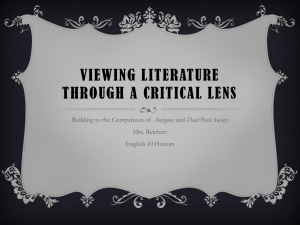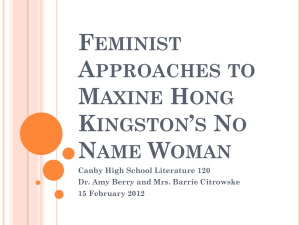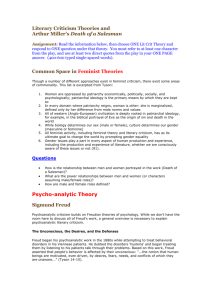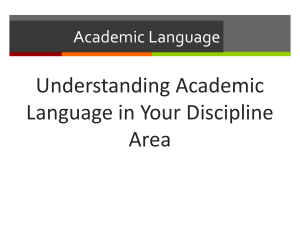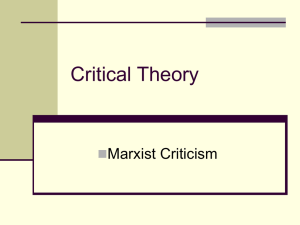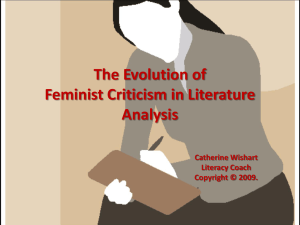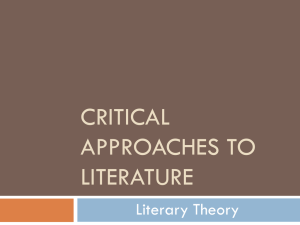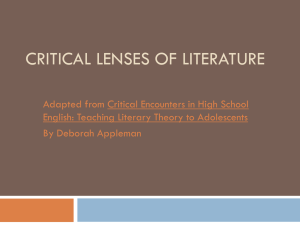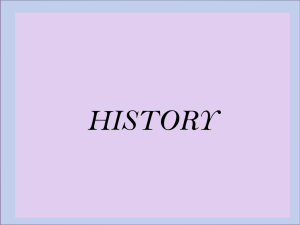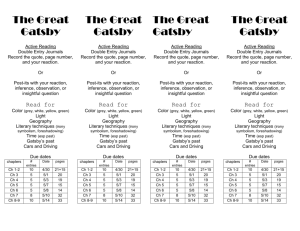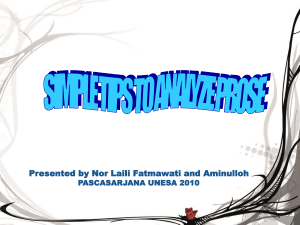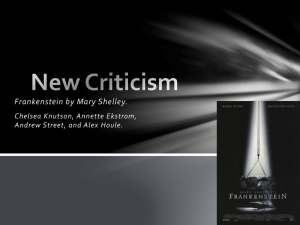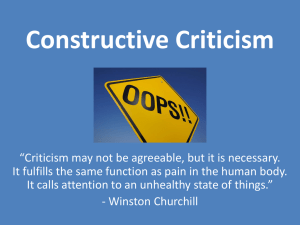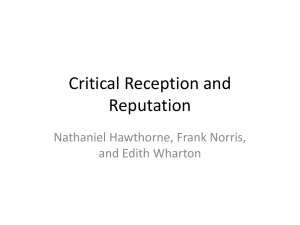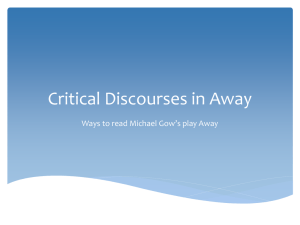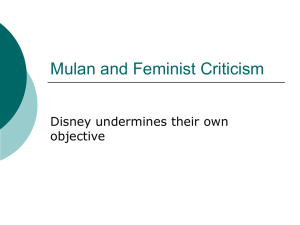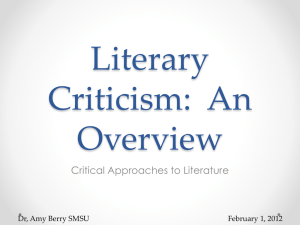Literary Criticism
advertisement
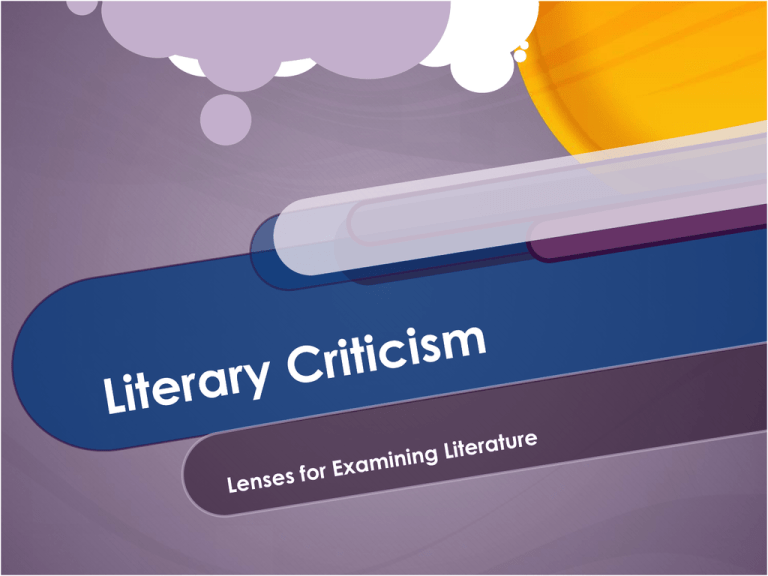
What is Literary Criticism? Schools of literary criticism are like sunglasses specially designed for driving. Driving glasses make red and green particularly bright to the wearer. Different theories make particular aspects of a piece of writing more obvious or crucial to the analyst. Why learn this? Looking at a novel, story, or poem through a particular lens helps us to notice things we wouldn’t otherwise. Some schools of thought are more relevant to a given work than others. Discussions about relevant approaches to literature are excellent practice in critical thinking. So, what have we been doing so far? We have used the New Critical approach thus far. The New Critical approach suggests breaking down a work in terms of themes, symbols, and characterization internally, seeking to attach meaning to literary elements. We have also approached literature study from the historic, archetypal, and multicultural lenses. More on this later… What other “lenses” are there? Feminist Reader-Response Marxist Historical Multicultural Others Psychoanalytic Formalism Environmentalism Feminist Criticism A feminist critic sees cultural and economic disabilities in a patriarchal society that have hindered or prevented women from realizing their creative possibilities Feminist critics see males as the dominant force, with women relegated to the role of defining objects for men. Assumptions of Feminist Criticism 1. Our civilization is pervasively patriarchal. 2. Concepts of gender are cultural constructs affected by patriarchal biases. 3. The patriarchal ideology pervades those writings that have been considered great literature. Those writings: -lack autonomous female role models -are implicitly addressed to male readers -leave woman readers as outsiders So, if I ask you to apply feminist criticism… Examine the patterns of thought and behavior in male-female relationships. Seek to identify values put forth about men and women’s roles. Look at the role of enfranchisement and power in relations between the sexes. Feminism and Current Works In Harry Potter and the Sorcerer’s Stone, Hermione is initially depicted as unattractive, both physically and socially. Would a smart young wizard get the same treatment? Why is the most evil instructor at Hogwarts a woman (Professor Umbridge)? In The Hunger Games, although Katniss is very strong, her mother’s weakness after her father’s death brings the family to poverty. Although strong, she would initially be described as masculine (a good hunter, a risk-taker) and struggles to be feminine (she is afraid to twirl in a dress). Marxist Criticism Assumptions Human history is determined by the changing mode of its material production--its basic economic organization. Historical changes in the fundamental mode of production effect essential changes in the power relations of social classes, which carry on a conflict for economic, political, and social advantage. A Marxist critic typically explains the literature in any era by revealing the economic, class, and ideological determinants of the way an author writes, and he/ she examines the relationship of the text to the social reality of the time and place. So if I ask you to apply Marxist criticism… Ask yourself: Who has the power and money in the piece of literature? Ask yourself: Who lacks these assets? Ask yourself: Why is that? Ask yourself: What is the effect? Marxism in Current Works The premise of The Hunger Games is based on power concentrated in the hands of a wealthy minority who manipulate a poor majority through fear. In Harry Potter, the Weasleys’ lack of wealth (versus, say, the Malfoy family) is a recurrent topic. The distinction between Pureblood and Muggle-born (“Mudblood”) wizards is another source of conflict. Psychoanalytic Criticism Psychoanalytic criticism deals with a work of literature primarily as an expression of the personality, state of mind, feelings, and desires of its author. The assumption of psychoanalytic critics is that a work of literature is correlated with its author’s life and mental traits. Terminology of Psychoanalytical Criticism Freud ID EGO SUPEREGO Oedipus & Electra Complex How to apply psychoanalytical criticism: Learn a little bit about the author, then look for potential links between the work of fiction and important elements of the author’s life. Identify symbols of key assumptions. Identify what issues the author seems to be “working out” in the text. Some examples: Shakespeare had a son, Hamnet, who died as a child. This tragedy caused Shakespeare immense grief, even rage. These emotions are expressed very clearly in his play Hamlet. Harper Lee calls To Kill a Mockingbird a “simple love story.” She had a father who was a lawyer in the South. Back to Hogwarts… J.K. Rowling was a single mother dependent on social welfare. Most of her “hero, or sympathetic characters are of a status that causes them to be looked down upon. Harry: orphan Ron & Ginny: poor family Hermione: Muggle-born Hagrid: half-giant Historical Criticism Using this theory requires that you apply to a text specific historical information about the time during which an author wrote. History, in this case, refers to the social, political, economic, cultural, and/or intellectual climate of the time. How to apply historical criticism: Determine the year, or span of years, in which a work was completed. Research major events, issues, and concerns of that time; then, look for links to the themes, symbols, events, and characters of the work at hand. Examples The play The Crucible is set in Puritan New England and revolves around the Salem witch trials. Arthur Miller wrote it in the 1950s and many of the events and themes reflect his disgust with the Communist “witch hunts” he observed. Many authors of the World War I era, including F. Scott Fitzgerald, were deeply affected by the “war to end all wars,” and therefore their characters embody a sense of loss, depression, and disconnection. Harry Potter Works With Everything J. K. Rowling used the Harry Potter series to convey her thoughts on important contemporary social issues, including class divisions (Chamber of Secrets), the prison system (Prisoner of Azkaban), and the British education system (Order of the Phoenix). Reader-Response Theory Suggests that literature does not, on its own, have any substantial meaning. Rather, meaning derives from the interaction between the individual reader and the text. If I ask you to use readerresponse analysis… Identify key features of the text. Identify your essential characteristics or beliefs. Look for ways they cross, connect, contradict, or relate to each other in interesting ways. The Phantom Tollbooth & Me This novel is about a boy who is always bored or who tires of any activity very easily. Milo is very independent and has no obvious parental oversight. The novel contains a tremendous amount of melodrama; for example, Milo ventures to a land where Rhyme and Reason have been banished…literally. They are two girls who Milo must free from a sky prison. “ CHAOS LURKS. The novel relies heavily on wordplay, searching for meaning, and wit. As a child, I was very bored in school. I was much happier reading or in unstructured environments. My parents were very supportive, but I couldn’t always talk with them about certain topics, and I couldn’t always have the autonomy I wanted. Milo’s independence appealed to me. As a high school teacher, encounter unpredictable situations daily. I love words of all kinds. I also love learning. Assumptions of Multiculturalism Race is biological, but culture is environmental. Literature can reinforce prejudices. Multicultural critics want us to learn about other cultures correctly. They believe that: 1. every human being deserves to be treated with integrity. 2. educators should teach about multi-cultural authors. 3. stories that are truthful about other cultures are celebrated 4. stories that have stereotypes or prejudices are identified/ challenged If I ask you to use multicultural analysis…. 1. Find all of the cultures in the literature, especially minority cultures. 2. Try to see how each culture is portrayed in the text. 3. Comment on stereotypical language and assumptions found in the text. Examples John Steinbeck’s novels challenge stereotypical beliefs about and the treatment of African Americans in mid-century America. For example, he portrays the black farm hand, Crooks, in a sympathetic light. Sandra Cisneros depicts the firm bond of Latino families in A House on Mango Street. Cisneros provides a rare glimpse of the both minority culture and minority experience.
